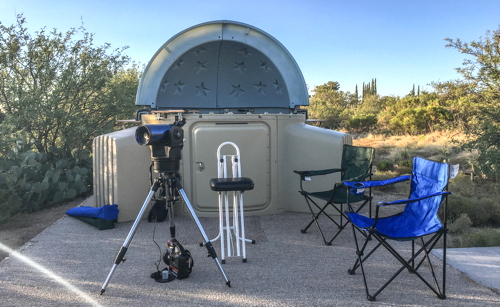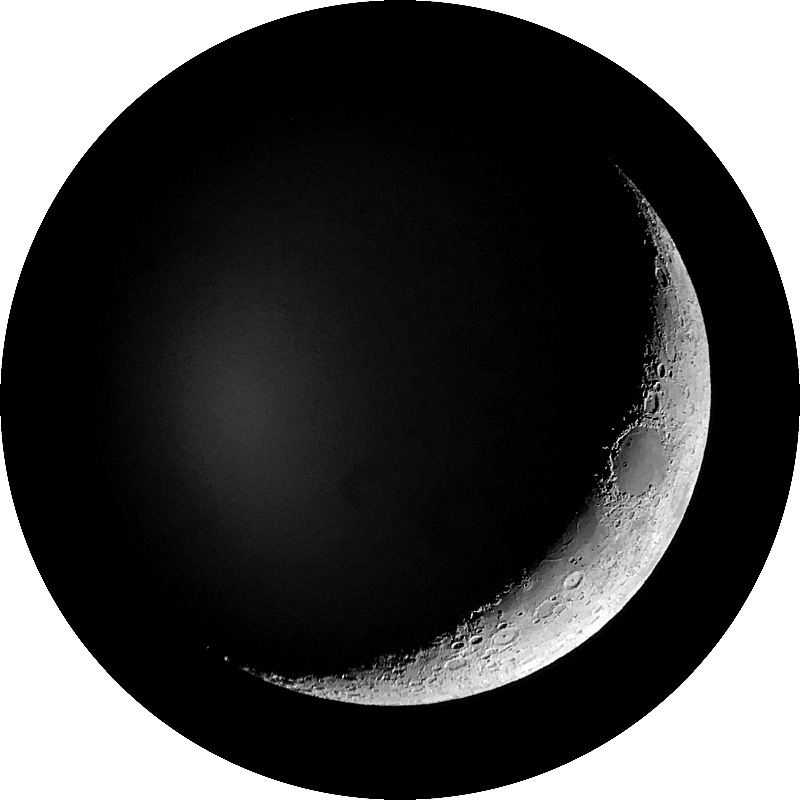Visitors Wanting to Enjoy a Dark Sky
Posted: 8 July 2016
Cloudy skies returned on Wednesday, 6 July 2016. The sky began clearing late afternoon on Thursday, 7 July. That was fortuitous as a couple visiting Oracle to celebrate their wedding anniversary wanted to experience the dark sky that is available here.
|
Open: Thursday, 7 July 2016, 1832 MST Temperature: 100°F |
Session: 993 Conditions: Mostly clear, breezy |
Equipment Used:
ETX-125AT
1.25" 26mm eyepiece
1.25" 3X TeleXtender
Camera:
iPhone 6s Plus
Before the guests arrived I set up the Meade ETX-125AT and some chairs on the observatory patio:

1937 MST: sunset. Jupiter was faintly visible to the naked eye against the bright blue sky. 1944 MST: picked up Mars with the naked eye. 1949 MST: the star Vega was now faintly visible. Turned the ETX ON and an Easy Align.
While waiting for the guests to arrive I viewed the crescent Moon, 73X. Took this handheld iPhone 6s Plus afocal photo:

1957 MST: Saturn was now an easy naked eye object. Viewed Jupiter and three of the Galilean Moons, 73X. Then viewed Mars, 73X. One large dark surface area was visible along with a hint of the North Polar Cap. Next viewed Saturn, 73X. Good view of the planet and Ring system. Cassini Division was visible. The moons Titan and Rhea were visible. I then returned to viewing the Moon while waiting for the guests to arrive.
2036 MST: my guests arrived. We briefly chatted about the area and my observatory. I then showed them several objects through the Meade ETX-125AT telescope. First up was the Moon, 73X and 219X. Clouds began appearing in the southwest. They then viewed Jupiter, Mars, and Saturn, 219X. The clouds were quickly moving northward and began impacting objects we were observing. They were able to view the following Messier catalog objects at 73X: M4 (globular cluster), M17 (Swan Nebula), M13 (Great Globular Cluster in Hercules), M57 (Ring Nebula, planetary nebula), M8 (Lagoon Nebula), M20 (Trifid Nebula), and M11 (Wild Duck Cluster, open star cluster). The colorful double star Albireo was also observed. During the night the Milky Way and several Earth-orbiting satellites were seen. Unfortunately, the sky became mostly cloudy by 2145 MST. We chatted some more. 2211 MST: the guests left after an enjoyable night of viewing. What an exciting way for them to celebrate their anniversary.
I then began closing up the observatory due to the clouds.
|
Close: Thursday, 7 July 2016, 2241 MST Temperature: 79°F |
Session Length: 4h 09m Conditions: Mostly cloudy |
Comments are welcome using Email. Twitter users can use the button below to tweet this report to your followers. Thanks.
Cassiopeia Observatory Home Page
Copyright ©2016 Michael L. Weasner / mweasner@me.com
URL = http://www.weasner.com/co/Reports/2016/07/08/index.html
